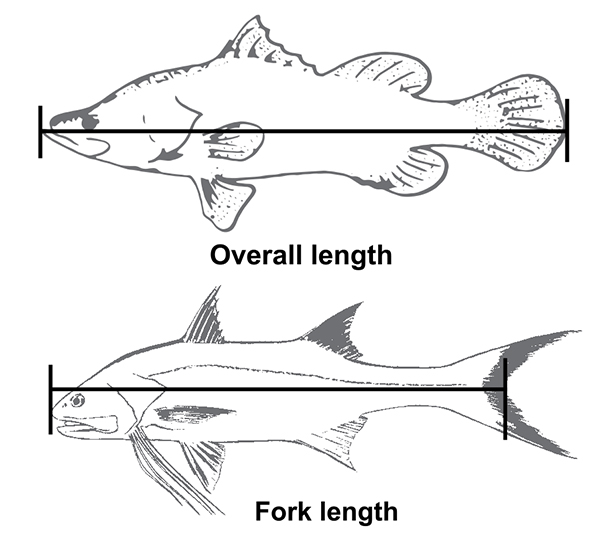Rules for keeping your catch
If you plan to keep your catch you must ensure it is of the legal size required in the Northern Territory (NT).
It is illegal to sell, trade, or barter your catch. It is illegal to tether fish, dead or alive.
Read about possession limits for fish.
When handling your catch you should:
- kill it humanely
- clean and fillet it properly
- don’t waste any of it
- store it so it will stay fresh.
How to measure fish
You should measure a fish with its mouth closed while lying it flat on a measuring device to comply with NT size limits.
For fish with a lower jaw longer than the upper jaw, like barramundi or cod, overall length is measured from the tip of the lower jaw to the middle ray of the tail fin.
For fish with an upper jaw longer than the lower jaw and with tail fin rays that appear to be the same length or concave, such as red emperor and mangrove jack, you should measure from the tip of the snout to the longest part of the tail fin.
For fish with a forked tail, like blue or king threadfin, you should measure from the longest part of the head to the fork of the tail. This is known as the fork length.

How to kill your catch humanely
If you keep fish and crabs you must handle them humanely after capture.
This will eliminate unnecessary stress to the fish and maximise the eating quality and storage life.
Fish
You should kill fish immediately after capture.
You should stun fish with a spike in the brain just behind the eye or with a sharp blow to the head before bleeding them.
Crabs
You should tie the crab claws to its body to avoid personal injury and damage to the crab.
Mud crabs can be tied and kept alive in a moist hessian bag in a cool place before they are killed.
You must kill mud crabs before you cook or process them.
To do this you must chill the crabs first then kill them by splitting or spiking them to destroy the nerve centre.
You should then place the crabs in ice water to reduce their core temperature.
This will improve the table quality of your catch whether you cook it fresh or freeze it.
Read how to store crabs below. Read about mud crabs, including how to cook them.
How to clean fish
If you are stopped by police officers or authorised persons, they must be able to identify the fish you have caught.
When cleaning your fish you must leave the entire skin on the fillets and trunks of all fish.
If you're going to keep and eat your fish you should process them properly.
Fish can be left whole without spoiling if killed properly and chilled right after capture.
You should remove all gills, intestines and blood to reduce spoilage.
Don’t break and spill gut contents or cut into flesh in the abdominal cavity as harmful microorganisms may enter cut flesh.
Edible parts of a fish
Almost every part of a fish can be used for cooking.
You can:
- scale and remove the 'wings', the pair of fins on either side just behind the head
- use the head and frame for fish soup or stock
- cook small reef fish whole.
How to store your catch
Once fish and crustaceans die they begin to spoil and should be chilled immediately.
Place your catch into an ice slurry of two parts ice and one part water.
Fish storage
Frozen fillets from different species must be kept separately.
A piece of fish, other than a fillet, is counted as one fish, unless you can prove that two or more pieces came from the one fish.
Crab storage
Crabs can be kept alive for days in a cool, moist, dark, fly-proof place.
You should place crabs in a well-ventilated plastic basket and cover them with a wet bag.
Give feedback about this page.
Share this page:
URL copied!